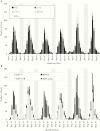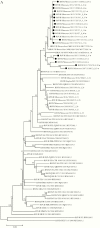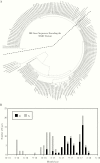Summer Outbreak of Severe RSV-B Disease, Minnesota, 2017 Associated with Emergence of a Genetically Distinct Viral Lineage
- PMID: 32083677
- PMCID: PMC7323494
- DOI: 10.1093/infdis/jiaa075
Summer Outbreak of Severe RSV-B Disease, Minnesota, 2017 Associated with Emergence of a Genetically Distinct Viral Lineage
Abstract
Background: Respiratory syncytial virus (RSV) typically causes winter outbreaks in temperate climates. During summer 2017, the Minnesota Department of Health received a report of increased cases of severe RSV-B infection.
Methods: We compared characteristics of summer 2017 cases with those of 2014-2018 summers. To understand the genetic relatedness among viruses, we performed high-throughput sequencing of RSV from patients with a spectrum of illness from sites in Minnesota and Wisconsin.
Results: From May to September 2017, 58 RSV cases (43 RSV-B) were reported compared to 20-29 cases (3-7 RSV-B) during these months in other years. Median age and frequency of comorbidities were similar, but 55% (24/43) were admitted to the ICU in 2017 compared to 12% in preceding 3 years (odds ratio, 4.84, P < .01). Sequencing was performed on 137 specimens from March 2016 to March 2018. Outbreak cases formed a unique clade sharing a single conserved nonsynonymous change in the SH gene. We observed increased cases during the following winter season, when the new lineage was the predominant strain.
Conclusions: We identified an outbreak of severe RSV-B disease associated with a new genetic lineage among urban Minnesota children during a time of expected low RSV circulation.
Keywords: molecular epidemiology; respiratory infections; respiratory syncytial virus; viral next-generation sequencing; viral pathogenesis.
© The Author(s) 2020. Published by Oxford University Press for the Infectious Diseases Society of America. All rights reserved. For permissions, e-mail: journals.permissions@oup.com.
Figures




Similar articles
-
Genomic characterization of circulating human respiratory syncytial viruses A and B in Kuwait using whole-genome sequencing.Microbiol Spectr. 2024 Jul 2;12(7):e0015924. doi: 10.1128/spectrum.00159-24. Epub 2024 May 29. Microbiol Spectr. 2024. PMID: 38808977 Free PMC article.
-
Genetic characterization of respiratory syncytial virus highlights a new BA genotype and emergence of the ON1 genotype in Lyon, France, between 2010 and 2014.J Clin Virol. 2018 May;102:12-18. doi: 10.1016/j.jcv.2018.02.004. Epub 2018 Feb 6. J Clin Virol. 2018. PMID: 29471266
-
Molecular characteristics and successful management of a respiratory syncytial virus outbreak among pediatric patients with hemato-oncological disease.Antimicrob Resist Infect Control. 2018 Feb 13;7:21. doi: 10.1186/s13756-018-0316-2. eCollection 2018. Antimicrob Resist Infect Control. 2018. PMID: 29449938 Free PMC article.
-
Prevalence of human respiratory syncytial virus circulating in Iran.J Infect Public Health. 2016 Mar-Apr;9(2):125-35. doi: 10.1016/j.jiph.2015.05.005. Epub 2015 Jul 2. J Infect Public Health. 2016. PMID: 26143136 Review.
-
Molecular epidemiology of respiratory syncytial virus.Rev Med Virol. 2001 Mar-Apr;11(2):103-16. doi: 10.1002/rmv.305. Rev Med Virol. 2001. PMID: 11262529 Review.
Cited by
-
Circulation patterns and molecular characteristics of respiratory syncytial virus among hospitalized children in Tianjin, China, before and during the COVID-19 pandemic (2017-2022).Virol Sin. 2024 Oct;39(5):719-726. doi: 10.1016/j.virs.2024.07.004. Epub 2024 Jul 26. Virol Sin. 2024. PMID: 39067791 Free PMC article.
-
[Prevention of infections by influenza virus and respiratory syncytial virus after removal of the lockdown measures].Monatsschr Kinderheilkd. 2021;169(11):1072-1074. doi: 10.1007/s00112-021-01278-7. Epub 2021 Aug 17. Monatsschr Kinderheilkd. 2021. PMID: 34421128 Free PMC article. Review. German.
-
Healthcare-Associated SARS-CoV-2 Reinfection after 3 Months with a Phylogenetically Distinct Omicron Variant: A Case Report.Viruses. 2022 Aug 23;14(9):1852. doi: 10.3390/v14091852. Viruses. 2022. PMID: 36146659 Free PMC article.
-
Respiratory Syncytial Virus Infection: Old Challenges and New Approaches.J Infect Dis. 2023 Jun 28;228(1):4-7. doi: 10.1093/infdis/jiad010. J Infect Dis. 2023. PMID: 36715631 Free PMC article. No abstract available.
-
Detection of respiratory syncytial virus defective genomes in nasal secretions is associated with distinct clinical outcomes.Nat Microbiol. 2021 May;6(5):672-681. doi: 10.1038/s41564-021-00882-3. Epub 2021 Apr 1. Nat Microbiol. 2021. PMID: 33795879 Free PMC article.
References
-
- Light M, Bauman J, Mavunda K, Malinoski F, Eggleston M. Correlation between respiratory syncytial virus (RSV) test data and hospitalization of children for RSV lower respiratory tract illness in Florida. Pediatr Infect Dis J 2008; 27:512–8. - PubMed
-
- Mullins JA, Lamonte AC, Bresee JS, Anderson LJ. Substantial variability in community respiratory syncytial virus season timing. Pediatr Infect Dis J 2003; 22:857–62. - PubMed
-
- Meissner HC. Viral bronchiolitis in children. N Engl J Med 2016; 374:62–72. - PubMed
-
- Falsey AR, Hennessey PA, Formica MA, Cox C, Walsh EE. Respiratory syncytial virus infection in elderly and high-risk adults. N Engl J Med 2005; 352:1749–59. - PubMed
Publication types
MeSH terms
Grants and funding
LinkOut - more resources
Full Text Sources
Medical

